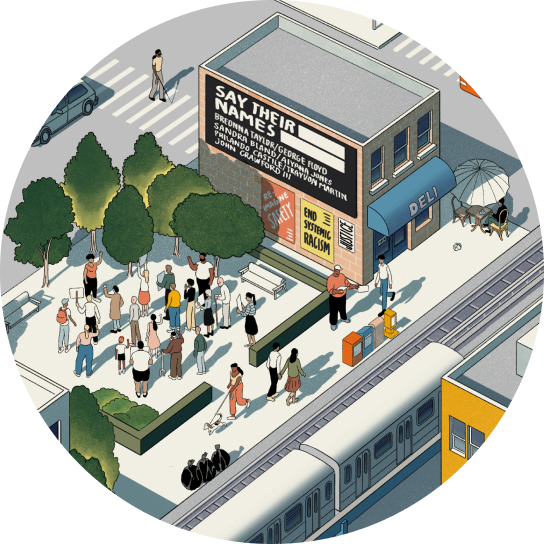
TAKE ACTION
We seek to empower communities to change the way that public safety is defined and delivered.
As the movement for racial equity and justice gained unprecedented momentum in the summer of 2020, communities made their needs clear. A complete change to the systems that have failed to deliver safety, equity, and opportunity to under-resourced and traditionally marginalized people in our society is decades overdue.
At CPE, we believe that systems that support White supremacy must be resisted and dismantled.
We recognize the long legacy of harm caused by the criminal legal system and police to non-White and vulnerable communities, especially to Black people. Our national history of police violence against Black, Brown, and other communities continues today. Because of this, there is significant distrust between marginalized communities and police that is a barrier to public safety.
An increasing number of police departments are responding to this call and taking steps to change their practices. But police cannot achieve meaningful change without partnering with the people directly impacted by over-policing. Reimagining public safety means that communities can voice their public safety concerns and identify the right tools and resources they need to feel safe.
A framework for taking action
There is no shortage of ideas for how to make policing more equitable and safe. But there is also no single pathway to improving policing. The tools on this page can help community members at various stages of this work assess solutions to take action to reduce disparities in police contact and reimagine public safety.
What types of solutions will improve equity in policing?
1
Reporting
Racial disparities in policing are often the result of a variety of deep-rooted and complex factors. Data is a powerful tool to not only shed light on existing harms and inequities, but also pinpoint issues driving inequity and opportunities to limit the scope of burdensome policing. To this end, several states have passed laws to require police departments to collect and publicly report data on traffic stops and other enforcement outcomes. However, in some places, there is still very little publicly accessible data about police contact with members of the public. Our guidance to departments on data collection and more detailed guidebook are good starting points for improving data collection, no matter your department’s current practices.
2
Regulation
Setting and enforcing clear, concrete expectations of officer behavior is one important way to promote equity and reduce harm caused by police. Science shows that when expectations are clear, officers are more likely to treat people equally. Departments, cities, states, and the federal government can all take steps to establish enforced norms and rules for police behavior. Two evidence-informed solutions that departments can implement to better regulate police behavior are to strengthen their written policies and improve their accountability systems. In order for public safety regulation to achieve equity, community members must have input and power in the regulation process. Our guidance to departments on implementing interventions outlines some initial suggestions for written policies, discusses different types of accountability systems to begin or evaluate, and describes how departments can engage communities in these efforts.
3
Redesign
Communities experiencing harmful and burdensome policing should have access to the resources they need to feel safe. Police are not the best option to meet many community needs they are routinely deployed to address, such as responding to mental health crises. At the same time, Black and Brown communities have historically experienced a lack of investment in educational, health, and other systems that would improve the safety and well-being of their residents. Communities across the country are taking meaningful steps to reduce the footprint of law enforcement and redirect limited budgetary resources to the support they need. For example, some cities are testing alternatives to armed police by sending medical professionals or social workers to respond to mental health, substance use, and other non-violent crises. Other cities are implementing alternatives to police responses to traffic enforcement and ending police presence in schools.
Resources
How to improve data collection
Our resources include key questions that community members can ask departments to help improve their policing data.
How to implement targeted interventions
We also offer recommendations for some initial ways departments can strengthen their written policies and accountability structures, which community members can use as guidance when engaging with their department to co-create solutions that help reduce inequitable policing and reimagine public safety.
